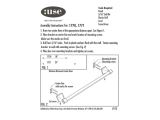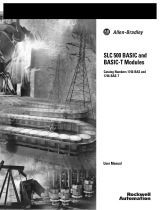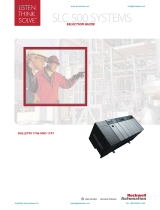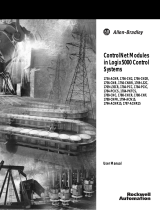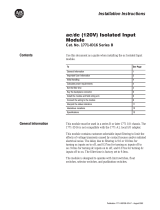Page is loading ...

Installation Instructions
Publication
17715.37 - October 1995
Selectable
Contact Output Module
Cat. No. 1771OWN
This document provides information on:
• important pre-installation considerations
• power supply requirements
• initial handling procedures
• installing the module
• using the indicators on the module for troubleshooting
• module specifications
This module must be used in a 1771-A1B through -A4B or later I/O
chassis.This module does not contain surge limiting circuitry. Use
this module for switching resistive loads only. It is not
recommended for inductive or capacitive loads.
The outputs are arranged in 4 groups of 8, each group with its own
common. The module can simultaneously switch all 32 outputs to
separate loads, with a maximum of 12A per module. Each output
can conduct a maximum load of 1.0A continuously at 30W
maximum. Ac loads switched by the modules should have a power
factor (PF) of 1.0.
Maximum interconnect cable length for this module is 1000 ft.
(304.8 meters).
European Union Directive Compliance
If this product is installed within the European Union or EEA
regions and has the CE mark, the following regulations apply.
EMC Directive
This apparatus is tested to meet Council Directive 89/336/EEC
Electromagnetic Compatibility (EMC) using a technical construction
file and the following standards, in whole or in part:
• EN 50081-2 EMC – Generic Emission Standard, Part 2 –
Industrial Environment
• EN 50082-2 EMC – Generic Immunity Standard, Part 2 –
Industrial Environment
The product described in this manual is intended for use in an
industrial environment.
To The Installer
Preinstallation
Considerations
Allen-Bradley Spares

2
Selectable Contact Output Module Cat. No. 1771-OWN
Publication
17715.37 - October 1995
Low Voltage Directive
This apparatus is also designed to meet Council Directive 73/23/EEC
Low Voltage, by applying the safety requirements of EN 61131–2
Programmable Controllers, Part 2 – Equipment Requirements and
Tests.
For specific information that the above norm requires, see the
appropriate sections in this manual, as well as the following
Allen-Bradley publications:
• Industrial Automation Wiring and Grounding Guidelines,
publication 1770-4.1
• Guidelines for Handling Lithium Batteries, publication AG-5.4
• Automation Systems Catalog, publication B111
The controller or I/O chassis power supply, connected through the
backplane of the I/O chassis, powers the logic circuitry of the contact
output modules. This supply also provides the necessary power to
energize the coils of the module relays. The maximum current drawn
from this supply when all coils are energized is 2.5A. Nominal
backplane current is 1.8A.
When handling the module, observe the following warning:
!
ATTENTION: Remove power from the 1771 I/O
chassis backplane and field wiring arm before
removing or installing an I/O module.
• Failure to remove power from the backplane or wir-
ing arm could cause module damage, degradation of
performance, or injury.
• Failure to remove power from the backplane could
cause injury or equipment damage due to possible
unexpected operation.
The contact output module contains components which can be
damaged by electrostatic discharge. The module is shipped in an
electrostatic shielded bag for protection. Follow the handling
procedures outlined below to guard against damage to your module.
• Touch a grounded object to discharge yourself before handling
the module.
• Do not touch the backplane connector or connector pins.
• If you configure or replace internal components, do not touch
other circuit components inside the module. If available, use a
static-safe work station.
• When not in use, keep the module in its static-free shield bag.
Power Supply
Requirements
Initial Handling Procedure

3
Selectable Contact Output Module Cat. No. 1771-OWN
Publication
17715.37 - October 1995
In this section we tell you how to key your I/O chassis, set the relay
output jumpers, install your module and make your wiring
connections.
Keying the I/O Chassis
Use the plastic keying bands, shipped with each I/O chassis, to key
your I/O slots to accept only this type of module. Place the keying
bands on the chassis backplane between:
• 6 and 8
• 16 and 18
Slots on the rear edge of the circuit board are matched to these slots
to allow insertion of this type of module. You can key any connector
in an I/O chassis to receive this module except for the leftmost
connector reserved for adapter or processor modules.
Setting the Relay Output Jumpers
When the output image table bit at the address corresponding to any
output is energized (set to 1), the corresponding relay contact is
closed or opened, respective to the jumper setting.
All outputs are individually selectable for either normally-open or
normally-closed operation. They are pre-set for normally-open
operation at the factory. To reset any jumper, proceed as follows:
1. Remove the 4 screws from the side cover and separate the circuit
board from the 2 covers.
2. Move the jumper to the desired position. Jumpers are identified
by jumper number and use (N.O. or N.C.). Refer to Table 1.A for
jumper and terminal identifications.
3. Reinstall the circuit board in the module and replace the cover.
N.O.N.C.
L-02
L-00
L-04
L-06
N.O.N.C.
Normally Open
Normally Closed
Printed Circuit Board
N.O.N.C.
RY10
RY9
RY2RY1
10538I
Installing Your Module
Allen-Bradley Spares

4
Selectable Contact Output Module Cat. No. 1771-OWN
Publication
17715.37 - October 1995
Table 1.A Jumper
Identification for Individual Outputs
Terminal
Number
Function
Jumper
Number
Terminal
Number
Function
Jumper
Number
1 Common 0 21 Common 2
2 Output 00 L00 22 Output 00 H00
3 Output 01 L01 23 Output 01 H01
4 Output 02 L02 24 Output 02 H02
5 Output 03 L03 25 Output 03 H03
6 Output 04 L04 26 Output 04 H04
7 Output 05 L05 27 Output 05 H05
8 Output 06 L06 28 Output 06 H06
9 Output 07 L07 29 Output 07 H07
10 Not used 30 Not used
11 Common 1 31 Common 3
12 Output 10 L10 32 Output 10 H10
13 Output 11 L11 33 Output 11 H11
14 Output 12 L12 34 Output 12 H12
15 Output 13 L13 35 Output 13 H13
16 Output 14 L14 36 Output 14 H14
17 Output 15 L15 37 Output 15 H15
18 Output 16 L16 38 Output 16 H16
19 Output 17 L17 39 Output 17 H17
20 Not used 40 Not used
Inserting the Module Into the Chassis
1. Turn off power to the I/O chassis.
2. Position the module so that the circuit board on the rear of the
module lines up with the top and bottom card guides in the
chassis.
3. Slide the module into the chassis.
4. Press firmly to seat the module in the chassis backplane
connector.
5. Swing the module locking latch down into place over the front
edge of the module.

5
Selectable Contact Output Module Cat. No. 1771-OWN
Publication
17715.37 - October 1995
Connecting Wiring to the Module
You make connections to the module through the field wiring arm
cat. no. 1771-WN. The arm pivots on the I/O chassis to connect with
terminals on the front of the module and acts as a terminal strip. The
wiring arm allows the module to be removed from the chassis
without disconnecting wiring.
1. Make certain all power is removed from the module before
making wiring connections.
2. Swing the wiring arm up into position on the front of the module.
The locking tab on the module will secure it into place.
3. Make your connections to the field wiring arm as shown in the
connection diagram. (Use the label on the front of the wiring arm
to identify your wiring.)
!
ATTENTION: The field wiring arm terminal
identification number is not the same as the number of
the bit which controls that output.
Connection Diagram for the 1771-OWN Module
Output 0
Output 2
Output 4
Output 6
Not used
Output 10
Output 12
Output 14
Output 16
Not used
Output 0
Output 2
Output 4
Output 6
Not used
Output 10
Output 12
Output 14
Output 16
Not used
Common 0
Output 1
Output 3
Output 5
Output 7
Common 1
Output 11
Output 13
Output 15
Output 17
Common 2
Output 1
Output 3
Output 5
Output 7
Common 3
Output 11
Output 13
Output 15
Output 17
Note: Contacts shown in N.O.
configuration for simplicity.
(Actual wiring runs in this direction.)
2
4
6
8
10
12
14
16
18
20
22
24
26
28
30
32
34
36
38
40
Note: Terminals on the left are
even numbered, and terminals
on the right are odd numbered.
10539I
Allen-Bradley Spares

6
Selectable Contact Output Module Cat. No. 1771-OWN
Publication
17715.37 - October 1995
!
ATTENTION: Do not attempt to increase load
current or wattage capability beyond the rating by
connecting two or more outputs in parallel. The
slightest variation in output relay switching time may
cause one set of contacts to switch the total load
current.
You can use the 1771-OWN output module to drive an input of a
120V ac input module (1771-IA, -IA2, -IAD) to indicate status of
turning on a motor starter as shown below, for example, but you
must connect a 15K, 2W resistor between the output and L2
(common). Inputs configured with the output module are not isolated
from each other.
Driving an Input Module with a 1771-OWN Output Module
120V AC Input Module
(Cat. No. 1771IAD)
Selectable Contact Output Module
(Cat. No. 1771OWN)
ac High
ac Low
L1
L2
Input 00
Input 01
Input 02
Input 03
Input 04
Input 05
Input 06
Input 07
Input 10
Input 11
Input 12
Input 13
Input 14
Input 15
Input 16
Input 17
1
2
3
4
5
6
7
8
9
10
11
12
13
14
15
16
17
18
19
20
21
Output 0
Output 2
Output 4
Output 6
Not used
Output 10
Output 12
Output 14
Output 16
Not used
Output 0
Output 2
Output 4
Output 6
Not used
Output 10
Output 12
Output 14
Output 16
Not used
Common 0
Output 1
Output 3
Output 5
Output 7
Common 1
Output 11
Output 13
Output 15
Output 17
Common 2
Output 1
Output 3
Output 5
Output 7
Common 3
Output 11
Output 13
Output 15
Output 17
10540I
15K ohm, 2W
resistor

7
Selectable Contact Output Module Cat. No. 1771-OWN
Publication
17715.37 - October 1995
The module has 32 status indicators on the module front plate. These
represent the control status of the output relays. Each indicator is lit
when its corresponding relay is energized.
00
01
02
03
04
05
06
07
10
11
12
13
14
15
16
17
Status Indicators (red)
00
01
02
03
04
05
06
07
10
11
12
13
14
15
16
17
10541I
Interpreting the Status
Indicators
Allen-Bradley Spares

Specifications
8
Selectable Contact Output Module Cat. No. 1771-OWN
Publication
17715.37 - October 1995
Outputs per module 32 (4 groups of 8)
Module Location 1771A1B thru A4B or later, 1771AM, AM1 I/O Chassis
Voltage Rating 24 138V ac rms; 24 125V dc
Current Rating
1
Max. per channel
Max. per module
Max. per group
1A continuous (derate linearly 0.033A/
o
C above 45
o
C)
12A (derate linearly 0.4A/
o
C above 45
o
C)
4A (derate linearly 0.133A/
o
C above 45
o
C)
Surge Current 1A (max) per output (at rated power)
2
Power Rating dc: 30W per output (resistive) maximum
ac: 30W per output (resistive) maximum
Minimum Contact Load 10mA
Operate/Release Time 5ms (+1ms) typical
Bounce Time 1ms (max)
Switching Frequency 10Hz (max)
Power Dissipation All relays off: 15mW; All relays on: 12.5W (max.)
Thermal Dissipation All relays off: 0.05 BTU/hr; All relays on: 42.75 BTU/hr (max.)
Backplane Current 2.5A maximum; 1.8A nominal
Isolation Voltage Isolation meets or exceeds UL Standard 508, and CSA Standard
C22.2 No. 142.
Interconnect Cable Length 1000 ft. (304.8 meters)
Conductors Wire Size
Category
14 gauge (2mm
2
) stranded (max)
3/64 inch (1.2mm) insulation (max)
1
3
Environmental Conditions
Operational Temperature
Storage Temperature
Relative Humidity
0 to 60
o
C (32 to 140
o
F)
40 to 85
o
C (40 to 185
o
F)
5 to 95% (without condensation)
Keying Between 6 and 8 and Between 16 and 18
Field Wiring Arm 1771WN
Wiring Arm Screw Torque 79 inchpounds
Agency Certification
(when product or packaging is marked)
• CSA certified
• CSA Class I, Division 2, Groups A, B, C, D certified
• UL listed
• CE marked for all applicable directives
1
Spikes, peaks and surges must be within the power rating. Resistive loads only
. ac and dc power = 30W max.
2
Surge limiting circuitry is not provided in the module. For reliable operation, the user must ensure that surges do not exceed either the voltage or
current rating of the module.
3
You
use this conductor category information for planning conductor routing as described in the systemlevel installation manual.
AllenBradley, a Rockwell Automation Business, has been helping its customers improve
productivity and quality for more than 90 years. We design, manufacture and support a broad
range of automation products worldwide. They include logic processors, power and motion
control devices, operator interfaces, sensors and a variety of software. Rockwell is one of the
world's leading technology companies.
Worldwide representation.
Argentina •
Australia
•
Austria
•
Bahrain
• Belgium • Brazil •
Bulgaria
•
Canada
• Chile •
China, PRC
•
Colombia
• Costa Rica •
Croatia
•
Cyprus
• Czech Republic •
Denmark
•
Ecuador
• Egypt • El Salvador • Finland • France •
Germany
•
Greece
•
Guatemala
•
Honduras
•
Hong Kong
•
Hungary
• Iceland •
India
•
Indonesia
•
Ireland
• Israel • Italy • Jamaica •
Japan
•
Jordan
•
Korea
•
Kuwait
•
Lebanon
• Malaysia • Mexico •
Netherlands
• New Zealand •
Norway
• Pakistan •
Peru
•
Philippines •
Poland
•
Portugal
•
Puerto Rico
•
Qatar
•
Romania
•
Russia-CIS
•
Saudi Arabia
•
Singapore
• Slovakia • Slovenia •
South Africa, Republic
• Spain •
Sweden
• Switzerland • T
aiwan
• Thailand • T
urkey
•
United Arab Emirates
•
United Kingdom
•
United States
•
Uruguay
• V
enezuela
• Yugoslavia
AllenBradley Headquarters, 1201 South Second Street, Milwaukee, WI 53204 USA, Tel: (1) 414 3822000 Fax: (1) 414 3824444
Publication
17715.37 - October 1995
PN955123-94
Copyright
1995 AllenBradley Company
, Inc. Printed in USA
/
